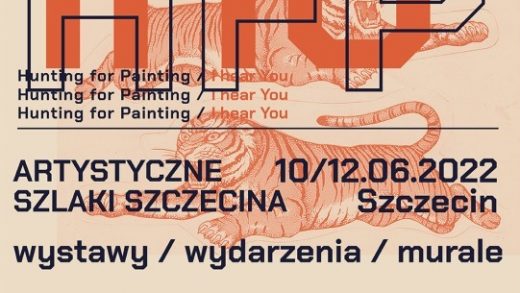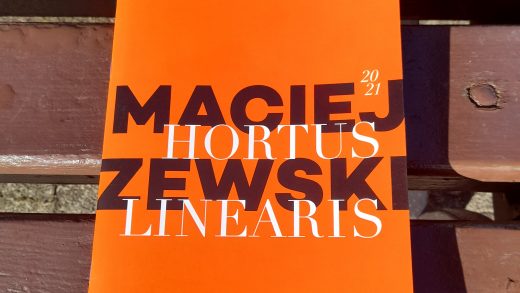opening: March 10th 2023, at 7:00 PM
exhibition: March 10th – April 21st, 2023
venue: Piekary Gallery, ul. Św. Marcin 80/82, Poznań
CK Zamek, The Rose Courtyard
exhibition open Mon. – Fri. from 10 AM to 6 PM
free entry
organized by

partner:

media patron:

“Returning to the darkroom after several decades is, in a sense, a profession of faith. The prints, releasing the silver from the whiteness of the paper, once again arouse demiurgic emotions, no longer weighed down by the preoccupation with the definition of image. Processuality, experimentation with the potential of silver and black, and the return to the motifs of figural repetition amplify the condensed tension of a motif that I confront with the nature of wood. The submissiveness of photographic paper allows me to explore the potential of the shape contained in the print. Ceramic clay is a new material for me, which does resemble the photographic modality when processed. Spherical forms are comprised within the right angles of the print or wood. The favourite 18 x 24 cm format is equivalent to the proportions of the human face that we turn towards the image. All works date from 2021 – 2023.”
Konrad Kuzyszyn, February 2023
“Repetition as mantric reinforcement of a motif
I have made several attempts to bring closer or describe what Konrad Kuzyszyn engages with. I call them attempts because, at best, they would only asymptotically reach the state of unsatisfactory contingency. Whatever I experienced communing directly with that unique activity would vanish—being—written. Elucidating Kuzyszyn’s inscrutable doings can only succeed if we heed Deleuze’s warning that ‘writing has nothing to do with meaning’. What purpose, then, is writing about Kuzyszyn supposed to serve? Is it to elucidate anything?
If this is ‘elucidation’ that one does, then the etymological connection with light may help solve many mysteries. However, in Deleuze’s terms, the link with cartography would be the most important. Placing signs on paper is common to the surveyor, the writer and the photographer.
The map drawn by Kuzyszyn reveals secret clusters of rare amalgams, sites where silver compounds corrupted and kaolin solidified, excavations of liturgical vessels and murky baths illuminated by a red glow. Each of these points mediates the alchemical genesis of transmutation. While in between, one should close their eyes (hazardous) and put your ear to the silver-clad trajectories. The sound of approaching meaning will explain the relationship between the photographer’s immobile eye and the mercury-filled underground lake surrounding the tomb of a Chinese emperor. Quicksilver—the living silver which effectively guards the access. However, the lake and the surface of the tray can be equally lethal. ‘A tray wrapped in darkness is a porcelain island emerging from the mist where alchemists of sensibility perform their daily transmutation.’[1]
At the bottom of the tray, a wad of paper is bobbing around, which at any moment can sink to its lowest state; it can be then fished out, crumpled into a ball and watched as it darkens in the bin, or, following Beckett’s example, one can ‘fail better’ and make it capture the shape of the vessel, whereas a cartographer may change the scale, changing the tray into a laguna morta that floods postcard cities….
The gaze of one coming out of the darkroom resembles the eyes of an epileptic struck by stroboscopic light, while the body still remembers the safe cocoon of darkness. In a tautological gesture, one can tear off one’s clothes and, in an embryonic pose, multiply the image to confuse the pursuers.
Most connoisseurs of photographic works do not think about the importance of the substrate, as if the image did not require paper whose whiteness is replaced by light. Kuzyszyn, the ‘momentary blind’, effects an autotelic turn by fusing the paper with the shape of the vessel. He juxtaposes the fixed photo-sensitivity with the impermanent memory of the paper. In doing so, he achieves the state of excess that the difference needs to come forth. Deleuze says: ‘The task of life is to make all these repetitions coexist in a space in which difference is distributed.’[2]
Kuzyszyn’s repetitions are mostly triplication or their multiples. It is an archetype possessed of magical significance, not unlike the illusive hares of the Paderborn Cathedral. In that peculiar optical illusion, each hare has a pair of ears, yet there are only three ears in total. The same motif, which corroborates the retrograde universality of the archetype, can be seen in an ancient vessel from a Persian mound.
The differences and repetitions of Kuzyszyn’s—son of a stage designer—are distributed in a meticulous entourage. It is an extremely accurate display; a precisely designed mechanism of revelation and microscopic curtains going down. The strength of that stage design lies in the mindfulness of the highest order. To complete the figure of fulfilments, I cite a reminiscence whose irrationality echoes Michel Leiris’s Nights as Day, Days as Night:
…Kuzyszyn and I descend slowly down the slope of the extinct Murodo volcano, the difference in pressure and sake making us sink into inemuri (the favourite state of the travelling Japanese). We move through a gorge of 10-metre-high walls of compacted snow, and when I open my eyes having woken up yet again, I can see through the profile of the sleeping Konrad , snow monkeys chasing the bus….
…three years earlier, in Venice, where the oldest biennale is underway, programmatically following John Berryman’s advice (I am bored by great art), I do not visit the exhibitions. At night, behind one of the countless bridges, I notice neon signs reflected in the water. One of them proclaims: ‘forms of vegetation: stumps and trunks’. In English, trunk means the body (of a growing tree) as well as the torso. A stump is what’s left when a tree has been felled…
That of statement of contiguity between the torso and the trunk harbours the ultimate inevitability that is not susceptible to any spell. Kuzyszyn clashes the torso’s with the surface of the wood, which in cartographic terms constitutes the most perfect map of the world. A black relief and the iconoclastic gesture of the pantocrator. The illusive concavity and illusive convexity of silver halides. Difference and repetition. Romantic egotism in compulsive gestures. Nights without nights in which lakes of living silver guard the access to the sarcophagi. Kuzyszyn’s secret rituals, the elucidation of which must remain pre-verbal, like the seed of a myth, or turn into a snow monkey chasing a bus with the sleeping Konrad aboard.”
Piotr Kurka, February 2023
[1] P. Kurka, Kuweta: instrukcja obsługi(perseweracje liturgiczne), text accompanying Wywoływanie/wołanie, an exhibition by Konrad Kuzyszyn at the Olimpus Gallery, Łodź, 8.06 – 3.07.2022.
[2] G. Deleuze, Difference et Repetition, Presse Universitaire de France, Paris 1968.



